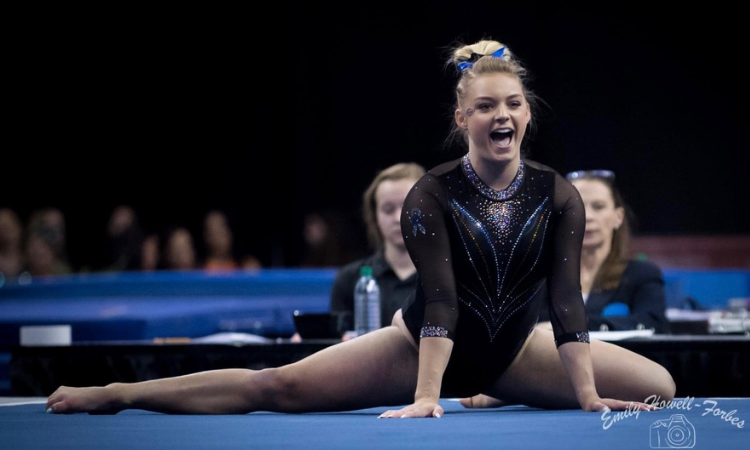Every gymnast dreams of going to the Olympics. A limited number make the elite level, let alone have the opportunity to compete at the Games. Somewhere on the path is college gymnastics: the happy marriage of the best level 10s and former elites competing and representing their schools every week. With Tokyo 2020 coming to a close and limited elite competitions throughout the year, if you’re itching for more gymnastics to watch, there’s no better time to dive into college gymnastics.
1. Elites Bring Unique Skills To College
The thrill and excitement of difficult, skill-packed routines leaves the elite stage on another level for many fans. While elite difficulty is unparalleled to college routines, that doesn’t stop some athletes from bringing their skills to college. Former Utah gymnast Mykayla Skinner competed a tucked double-double as her opening floor pass, and UCLA alumna Peng-Peng Lee had a difficult bar routine that featured a Bhardwaj. Additionally, many former elite and top level 10 athletes will compete double-twisting Yurchenkos on vault.
2. Former Elites Compete in NCAA Too
Though NCAA eligibility rules prohibit those gymnasts who turn pro from competing in college, for the remaining former elites, college gymnastics becomes a reality. Whether it’s high profile gymnasts like Olympians Kyla Ross, Bridget Sloan and Samantha Peszek, top-tier competitors who fell just short of their Olympic dreams, sentimental favorites who never quite made it or lesser-known names, many find their home and even thrive in college. For an elite fan interested in following NCAA gymnastics, these familiar faces provide a great stepping stone into the college world.
3. Internationals Come to College
Beyond the U.S., a handful of international elite gymnasts choose to come to the States and compete for a college team. It’s always interesting to see which gymnasts choose to go this route, providing them with an opportunity to continue competing and fans with the chance to learn and love more names than they may have otherwise. Brit Ruby Harrold became a fan-favorite at LSU and Germany’s Pauline Tratz is entering her 5th year at UCLA. You may even discover an elite for a lesser-known gymnastics country by watching NCAA gymnastics!
4. NIL Provides Opportunities for More Top Elites
Recently passed rules allow collegiate athletes and recruits to make money off their name, image and likeness. While a gymnast still wouldn’t be able to accept prize money for elite competitions, the ability to profit off endorsements, sponsorships and brand deals while still maintaining eligibility means the decision to go pro or compete in college is a less difficult decision. The expectation is athletes like Suni Lee and Jade Carey are more likely to make the transition to college gymnastics, as they still have the opportunity to make money on the popularity they gained from their elite achievements.
5. Focus on the Team
While there are team competitions in elite, the main focus is on the individual. In college, the team is the focus. If you like watching team competitions, you’ll like college gymnastics. With this comes a unique strategy for lineups and routine construction. Further, the enthusiasm and emotion shown in a college competition—whether it be cheering teammates, fun floor choreography, or teammates doing a gymnast’s choreography on the side of the mat—takes the sport to another level.
6. Focus on Execution
Although the difficulty level in college has increased with more elites pursuing that path, execution still reigns supreme. It’s refreshing to watch athletes compete flawlessly time after time, compared to the sometimes-messy or less-than-perfect routines fans often experience in elite.
7. Perfection is Possible
Let’s face it.. If McKayla Maroney couldn’t achieve perfection on her 2012 team final Amanar in London, we may never see a perfect score again. However, perfect 10s occur on an almost-weekly basis during the college season (whether some of those 10s are warranted or not).
8. Meets Every Week During Season
In college, teams compete weekly from January to April. While some teams may take a bye week, fans will have a plethora of meets to choose from for over 12 straight weeks at the start of the year. Compared to elite, your gymnastics cravings can be satisfied week after week across multiple meets.
9. Growth in Coverage
Over time, college gymnastics has grown in popularity among fans and gymnasts, and is increasingly being covered and aired by large networks. ESPN features Friday Night Heights on the SEC Network most weeks from January to March. In 2021, the NCAA gymnastics championship was aired on ABC and became the most watched NCAA gymnastics final in history.
10. 2022 Promises to Be the Best Season Yet
Between COVID years, 2020 Olympians and other star gymnasts, 2022 is bound to excite. Shallon Olsen, Brooklyn Moors, Jade Carey, Sunisa Lee, Grace McCallum and Jordan Chiles are all expected to compete during in the 2022 gym season, along with the return of fan favorite fifth years like Alyssa Baumann, Lynnzee Brown and Pauline Tratz. You don’t want to miss it!
READ THIS NEXT: A Four-Year Fan’s Guide to NCAA Gymnastics and the Olympics
Article by Tara Graeve and Katie Walsh
Like what you see? Consider donating to support our efforts throughout the year! [wpedon id=”13158″]




